S 936a - Tripolis (Antony), bronze (Antony/Fulvia) (42/41 BCE)
From SILVER
42 BCE - 41 BCE Bronze
Description
| ObverseInscription or printing placed on the obverse.: | Bare head of Antony right |
| ReverseInscription or printing placed on the reverse.: | TPIΠOΛITΩN L ΓK (date) (Greek).Draped bust of Fulvia right |
Mint and issuing power
| MintIdentifies the place of manufacture or issue of a numismatic object.: | Tripolis | Ancient regionAncient region.: | Phoenicia | Modern countryModern country: Lebanon | AuthorityIdentifies the issuing power. The authority can be "pretended" when the name or the portrait of X is on the coin but he/she was not the issuing power. It can also be "uncertain" when there is no mention of X on the coin but he/she was the issuing power according to the historical sources: | Marcus Antonius (Roman politician and general, member of the Second Triumvirate, 83-30 BC), Roman Republic |
Chronology
| FromIdentifies the initial date in a range assigned in a numismatic context. | 42 BCE | toIdentifies the final date in a range assigned in a numismatic context.. | 41 BCE | PeriodTime period of the numismatic object.: Hellenistic 323-30 BC |
Physical description
| MetalThe physical material (usually metal) from which an object is made.: | Bronze |
Median weightMedian of the weights of numismatic objects (in grams). in grams | 10.00 | DenominationTerm indicating the value of a numismatic object. Examples: tetradrachm, chalkous, denarius.: | StandardStandard.: |
Image

S936a Tripolis Antony.jpg [1]
References
| Die study referencePublication of the study: | Olivier - Aumaître 20171Olivier - Aumaître 2017, p. 112-113 | ||
| Coin series referenceReference to coin series study: | RPC I2RPC I, n° 4509 | ||
Obverse dies distribution
| FrequencyFrequency of specimen in distribution. ᵖ | Number of obversesNumber of obverse dies. ᵖ (o) | % (o) | Number of coinsNumber of coins. (n) | % (n) | Die nameName(s) of the die(s). |
| 2 | 1 | 50 | 2 | 25 | 1 |
| 6 | 1 | 50 | 6 | 75 | 2 |
| Total | 2 of 2 | 100 | 8 of 8 | 100 |
Reverse dies distribution
no distribution is available
Quantification
| Number of obversesNumber of obverse dies. ᵖ (o) | 2 | Number of singletons (o1)The number of singleton coins. ᵖ | |
| Number of reverse diesNumber of reverse dies. (r) | 3 | Number of coinsNumber of coins. (n) | 8 |
| Coins per obverse dieNumber of coins per obverse die. (n/o) | 4 | Coins per reverse dieNumber of coins per reverse die. (n/r) | 2.67 |
| Reverse per obverse ratioRatio of obverse dies divided by reverse dies. (r/o) | 1.5 | Percentage of singletons (o1)number of coins (n) divided by the number of singletons (o1) ᵖ | % |
| Original number of dies (O) (Carter 1983 formula)The estimation of the number of coins according to Carter 1983 ᵖ | 2.33 | Coins struck if 20,000 as average productivity per dieCoins made if the average productivity for obverses (according to Carter) is 20,000. ᵖ | 46,600 |
| Original number of dies (O) (Esty 2011 formula)The estimation of the number of coins according to the singleton formula in Esty 2011 ᵖ (O) | 2.67 | Survival rate if 20,000 as average productivity per dieSurvival rate if average productivity is 20,000. ᵖ | 0.00017 |
| Coverage (o = % of O) (Esty 1984 formula)Esty 1984 - coverage (% of O) ᵖ (o = % of O) | % | Die productivity if survival rate 1/2,000Average productivity if survival rate is 1/2,000. ᵖ | 6,866.95 |
| Weight of silver (in kg) if 20,000 coins per die (O = Carter formula)Carter 1983 * Median weight * 20000 (*10 if gold or electrum) ᵖ | n.a. | Die productivity if survival rate 1/5,000Average productivity if survival rate is 1/5,000. ᵖ | 17,167.38 |
Remarks
Most likely one single workstation